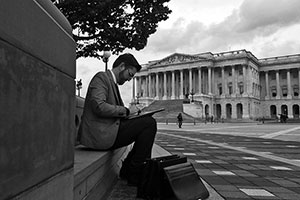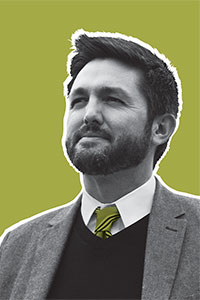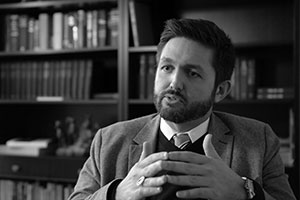First Wordsmith
During the George W. Bush administration, Troy Senik (MPP ’07) was one of the voices behind the most powerful man in the world. Today, he continues to shape public opinion in his own words
In a Mother’s Day radio address dated May 10, 2008, then-president George W. Bush celebrated matriarchs far and wide for their contributions to their families and to their nation. In the days leading up to the sentimental 448-word proclamation, 24-year-old White House speechwriter Troy Senik, with the help of four fact-checkers, was gathering documents to help President Bush reference a historical—and fairly famous—declaration of love by Abraham Lincoln to his mother. After extensive review, it became an open question as to whether Lincoln was speaking about his biological mother or his stepmother, a detail that did not materially affect the speech, but sent the speechwriting staff on an 18-hour quest to try to deduce from the historical tea leaves who Lincoln was actually referring to. In the end, the fact-checkers could not resolve the question with perfect clarity, and the line was struck from the speech.
 “There was a lot of pressure,” recalls Senik, who, over the course of his career in
the White House, was responsible for sorting through both obscure facts that were
difficult to track down and those that were so universally known that they were never
questioned. “Nobody wants to be responsible for letting one get past the goalie.”
“There was a lot of pressure,” recalls Senik, who, over the course of his career in
the White House, was responsible for sorting through both obscure facts that were
difficult to track down and those that were so universally known that they were never
questioned. “Nobody wants to be responsible for letting one get past the goalie.”
But it would be hard for Senik, whose writing mostly focused on economics, trade, and foreign policy, to fumble so spectacularly. Political speechwriting is intensely collaborative, and drafts of each speech he and the five other staff writers crafted were shared with multiple departments of the White House—sometimes up to 18 different offices—including the communications team, chief of staff, all associated policy or political areas, and the appropriate cabinet departments. These groups would, after heavy review, return the drafts with their respective set of notes to the writers to synthesize and revise in order to produce a final draft of the speech for the president.
Not all assignments were fraught, however, and the speechwriting team enjoyed many lighthearted moments, such as one Senik remembers about the work they produced on the occasion of the unveiling of President and Mrs. Bush’s official portraits at the National Portrait Gallery.
“The writers had gotten into a secret contest to see if we could find a way for the president to mention every one of his predecessors in the speech,” he recalls. At the podium, President Bush dutifully shared an anecdote the team had written about the portrait collection and referenced some of the past presidents featured in the gallery—a total of seven: John Q. Adams, Martin Van Buren, John Tyler, James K. Polk, Millard Fillmore, Franklin Pierce, and James Buchanan.
Spoken word, Senik explains, is central to the public’s understanding of a political message, and the degree to which it is fine-tuned has deep and wide implications for the person in power and the public he or she hopes to influence.
 “Most people don’t have the time to get into incredible depths on any of these particular
issues, and that’s what makes this type of communication so important,” says Senik,
who also spent time wordsmithing political prose for notable politicians Arnold Schwarzenegger
and Newt Gingrich. “ must be able to distill complicated ideas into short, pithy, and intelligible formulations
for people who just don’t have enough time to go deeper.”
“Most people don’t have the time to get into incredible depths on any of these particular
issues, and that’s what makes this type of communication so important,” says Senik,
who also spent time wordsmithing political prose for notable politicians Arnold Schwarzenegger
and Newt Gingrich. “ must be able to distill complicated ideas into short, pithy, and intelligible formulations
for people who just don’t have enough time to go deeper.”
Today Senik serves as vice president of policy and programs at the Manhattan Institute, a New York think tank. While his work is a bit removed from his speechwriting days in Washington, it accomplishes a similar goal: presenting complicated ideas in a way that makes sense to people who haven’t spent a lifetime studying them.
“Obviously, the most important goals for us are to make arguments that are persuasive and to get people to change their minds,” he says. “But even if people don’t agree with us, we still count it as a victory if we’ve made the issue clear for them and if they feel like they have a better sense of what’s going on and what’s actually being debated.”
A master of the written and spoken word, Senik, over the course of his career, has influenced public debate in the realms of public policy and media as opinion editor at the Daily Journal, vice president of programs at the Los Angeles World Affairs Council, editor in chief at Ricochet.com, columnist and member of the editorial board at theOrange County Register, and host of a podcast series at the Hoover Institution at Stanford University before signing on with the Manhattan Institute.
Senik’s current role is to identify and recruit those individuals—scholars, writers, and people with backgrounds in government—who have original ideas, can communicate them to the public, and have the potential to shape what public policy debate looks like. This team of subject matter experts, and their research of the law, economics, energy, education, and beyond, engages in discourse through written word, testifies at government hearings, and sparks national conversation through TV, radio, social media, and other various media.
Now nearly 10 years and two administration changes after Senik’s stint in the White House, presidential speech has evolved and taken on a new meaning thanks to the advent of the unfiltered medium of social media and the immediacy of communication between a political leader and his or her public. Trends over the last decade, however, indicate that presidential popularity often increases when the frequency of their appearances or communications decreases. Senik explains that, after a while, audiences become desensitized to repeated arguments and suggests that people in positions of power, especially commanders in chief, should make themselves more scarce in order to get more value out of the speeches they deliver.
 “ become such ubiquitous figures, and I think that most would probably be more effective
if they were more selective about when they decided to give a big speech, especially
one that was intended to move public opinion,” he says. “One of the difficulties you
face now is, ‘Does anybody have the attention span to get through an entire presidential
speech?’”
“ become such ubiquitous figures, and I think that most would probably be more effective
if they were more selective about when they decided to give a big speech, especially
one that was intended to move public opinion,” he says. “One of the difficulties you
face now is, ‘Does anybody have the attention span to get through an entire presidential
speech?’”
Data says no. A watershed study conducted in 2008 by Lloyds TSB Insurance discovered that the attention span of the average American is limited to five minutes—a whopping seven minutes fewer than when the study was conducted 10 years prior. While duration matters, Senik says the most engaging and memorable speeches throughout history are those delivered by individuals who talk in parables—“people who give you a story and a principle embedded in that story that illuminates the bigger issue.” He explains that this type of speech tends to be more persuasive than merely verbalizing facts that can be found on a spreadsheet, a format that would undoubtedly contribute to the loss of the already brief focus of the average audience member. “It’s the way the human brain processes information,” he says. “If you embed it in a narrative, it tends to be a little more memorable.”
When Senik recalls the American presidents who have had a lasting impact on the public far beyond their time in office, he notes that they all have something in common: a significant rhetorical legacy.
“When we talk about modern presidents,” he says, “the average person is more likely to call to mind a line in a speech; they might recall Reagan’s ‘Mr. Gorbachev, tear down this wall’” before they go through a litany of legislative accomplishments or talk about a tax bill. And this is uniquely amplified when it comes to presidents because they’re on TV every night, so you hear every utterance. For the people who are really good at it, I think it’s a real accelerant to being historically important.”
After establishing his own voice in the realm of public influence, Senik still credits the School of Public Policy—and its liberal arts approach—with uniquely equipping him to navigate and weave together the many threads that intersect in the world of public policy.
“Pepperdine gives students the same content as other programs—the economics, the statistics, the quantitative analysis, and the case study work that puts them in the strategic management mind-set,” he says. “But it also provides the political philosophy and the American history and constitutional law. Nothing the world of public policy is just an economics issue. There’s also going be a legal component to it. There’s going to be a political component to it. There’s going to be a philosophical component to it. There’s going to be an ethical component to it. The comprehensive and global way Pepperdine thought about policy has provided me with the tool kit I need to do my job here. I wouldn’t have had it otherwise.”
